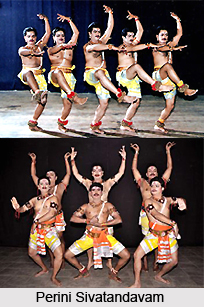 Perini Sivatandavam or Perini Thandavam is a typical form of dance that belongs to the warrior clan of 11th century AD. This is actually a male dance form performed in the Shiva Temple as an invocation to the Lord Rudra. The 11th century rulers of Kakatiya, Ganapathi Deva, Pratapa Rudra Deva of Warangal and Rani Rudrama Devi were all worshippers of Lord Shiva and tremendously helped the warrior dance form. This art, after the fall of Kakatiyas, disappeared from the scene due to lack of patronage.
Perini Sivatandavam or Perini Thandavam is a typical form of dance that belongs to the warrior clan of 11th century AD. This is actually a male dance form performed in the Shiva Temple as an invocation to the Lord Rudra. The 11th century rulers of Kakatiya, Ganapathi Deva, Pratapa Rudra Deva of Warangal and Rani Rudrama Devi were all worshippers of Lord Shiva and tremendously helped the warrior dance form. This art, after the fall of Kakatiyas, disappeared from the scene due to lack of patronage.
History of Perini Sivatandavam Dance
Perini Sivatandavam which is an ancient dance form from South India originated and prospered in Andhra Pradesh during the Kakatiya dynasty. It was Kakatiya Temples (1100 - 1300 AD) which inspired Guru Nataraja Ramakrishna to recreate "Perini Sivatandavam". A meticulous study of Nrittaratnavali of Jayapa Senapati, a dance treatise written in Ganapathi Deva`s (1199 - 1261 AD) courts, and the sculptural representation on the thousand pillared temples and shrines at Palampet and Ghanapur in Warangal district provide important insights into a powerful and vigorous masculine dance style that was performed to inspire and invigorate warriors before going to the battle field.
Performance of Perini Sivatandavam Dance
Perini Sivatandavam is believed to be the most invigorating male dance form. This pure form of dance incorporates Vira, Raudra rasas of Lord Shiva whose spirits are invoked by dancers. This dance form mainly involves five elements including Water, Air, Wind, Earth and Fire and celebrating the mystic "Om". One of the interesting parts about this form is the music that is used. The use of Bells, Drums, Conch and Rhythmic Syllabus change the entire atmosphere helping the dancers to reach a point of frenzy.
Perini Sivatandavam is mainly the dance of warriors and derives its name from "prerana", which means inspiration. The warriors performed this dance before the idol of Lord Nataraja, as a mode of worship, before leaving for the battlefield with the motto of invoking Shiva to dance through them. The dance begins with Gargara and ends with Shiva Panchamukha Shabda Nartanam in praise of Lord Shiva.
The dancers perform energetically to the rhythm of drums. This continues till they feel the power of Shiva in their bodies. This dance can be said as both of spiritual and artistic significance.
This particular dance form is in vogue and was promoted in the reign of kings of Kakatiya Dynasty in Warangal. This is well evident from the fine and detailed sculptures of this dance at Ramappa temple in Palampet.




